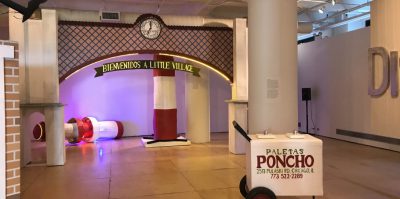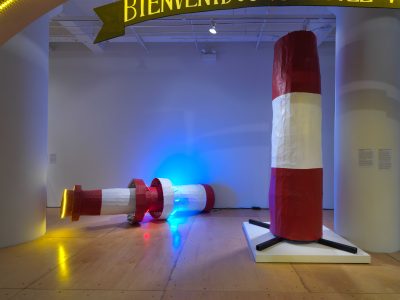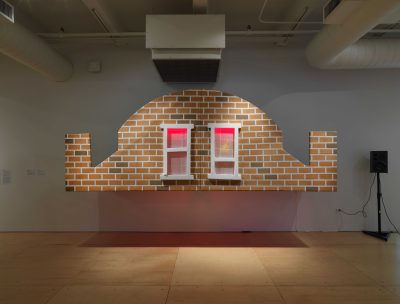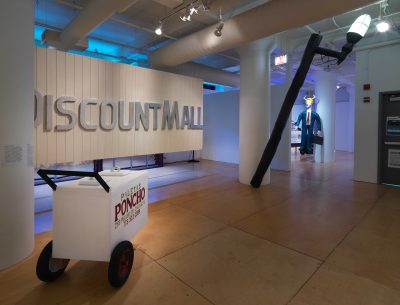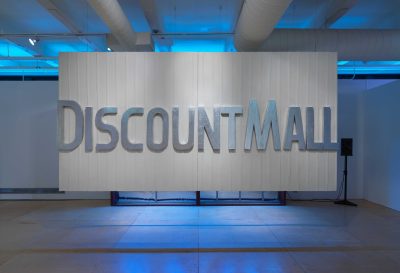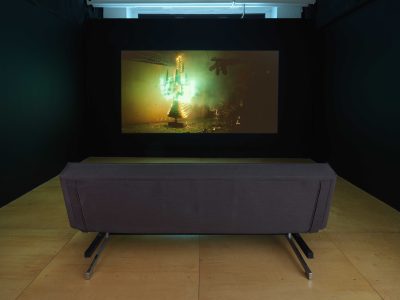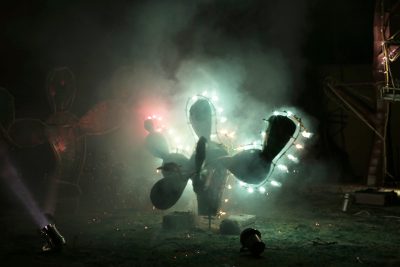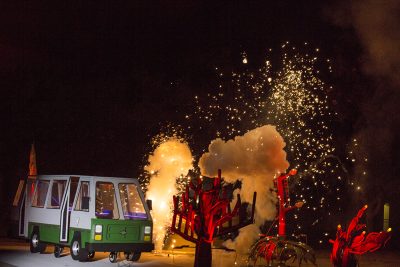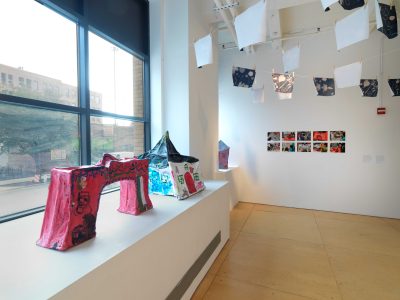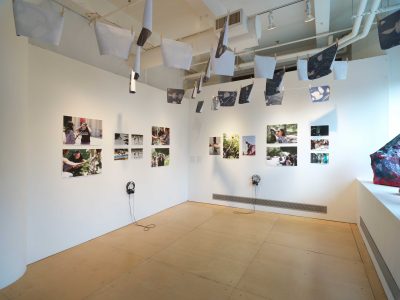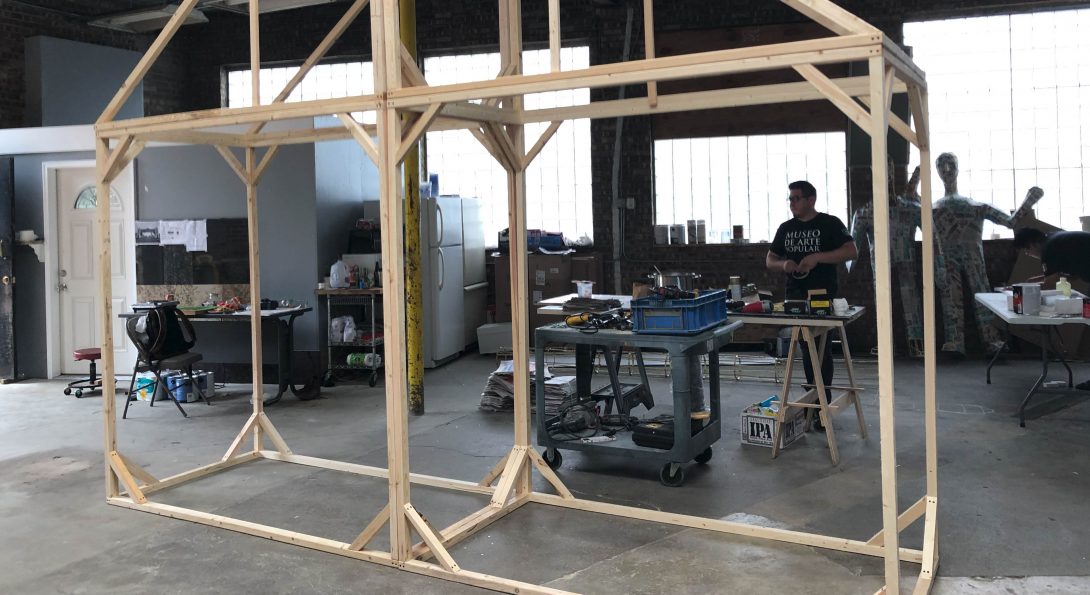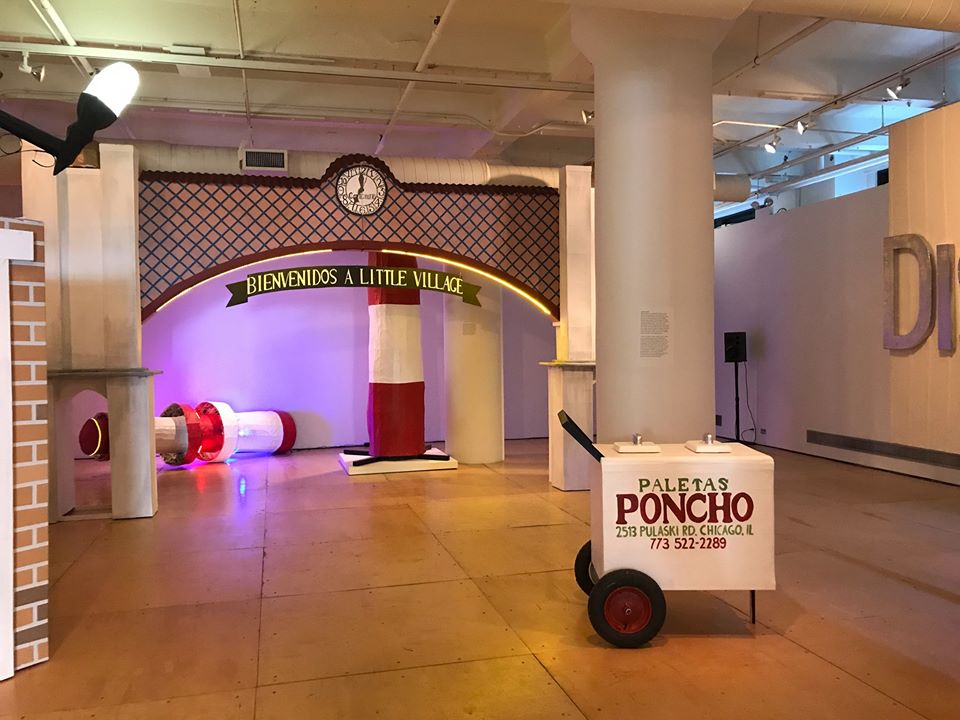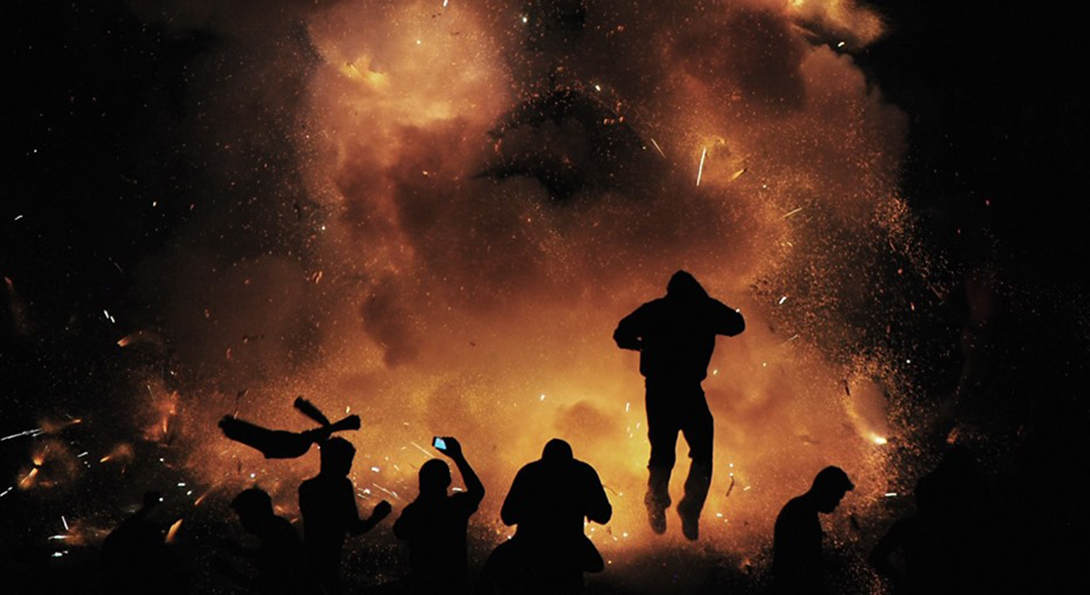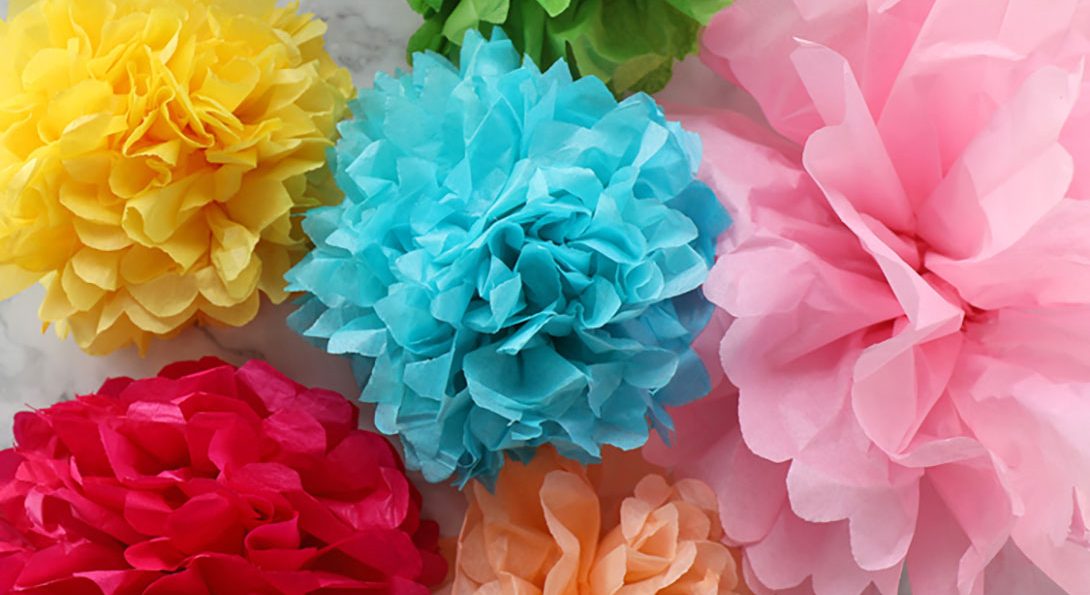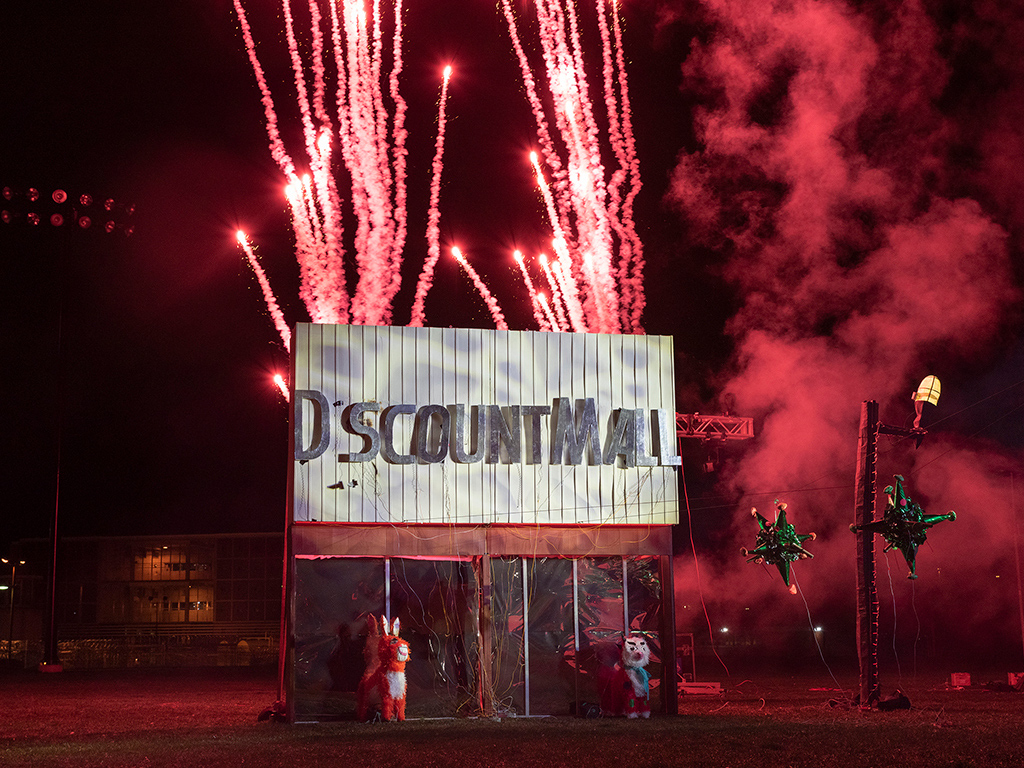Exhibitions
ABOUT THE EXHIBITION
Centered on the community interests of residents in Chicago’s Little Village neighborhood, Adela Goldbard’s The Last Judgment features large-scale sculptures built as pyrotechnic scenography for a public pyrotechnic event to be presented in Little Village in Spring 2020 (TBD). As a multi-part project, The Last Judgment creatively draws on Mexican traditions and artistry to spectacularly address and ritually purge the challenges facing Chicago’s Little Village.
The sculptures—built by master artisans of Artsumex collective in Tultepec (Mexico’s pyrotechnic capital)— derive from the struggles, life experiences, and resilience of Little Village residents, as well as concerns about environmental justice and gentrification. The sites, sets, and stories were collaboratively determined in a series of summer 2019 workshops that Goldbard and collaborating teaching artists held with multigenerational Little Village residents in schools, community centers, and other neighborhood locations. The Last Judgment is a bridge between organization, artists, artisans, activists, Mexican and Mexican-American communities across Chicago neighborhoods and across the border.
With a multilingual narrative (Spanish, English, and Náhuatl), The Last Judgment’s takes its name from the first Western play performed in present-day Mexico. In the XVI century, Franciscan priest Andrés de Olmos wrote The Last Judgment in Náhuatl as a religious tool of conquest. Goldbard’s Last Judgment evokes the spectacular character of that theater of evangelization but contests its colonizing and moralizing spirit, transforming punishment and subjugation into protest and criticality through processes of collective building, reenactment, and destruction.
In the performance, pyrotechnic effects and fireworks use special effects and to partially destroy the sculptures, transforming the spectacle into an allegorical, cathartic collective purging of the social ills addressed in the narratives. As such, the performance will trace a link between the spectacular use of fireworks in Spanish evangelical theater and present-day Mexican practices of burning effigies, whether Judas Iscariot, pop cultural icons, monsters and mythical creatures, or political figures. The Last Judgment adopts the allegorical destruction of evil embedded in these pagan, religious, and political pyrotechnic immolations of effigies and becomes both a protest and a celebration.
The Last Judgment builds on Goldbard’s practice of initiating collaborative artworks that are ritually and cathartically destroyed. Goldbard has, over the last six years, been developing and presenting public performances that feature the ritual destruction of large-scale sculptures in allegories of contentious Mexican historical and contemporary events. For Goldbard, “Collectively building, staging, and destroying has the potential to generate critical thinking and social transformation.” Past performances have been staged in multiple public squares of Mexican cities, such as Zacatecas and Queretaro City, as well as at Pomona College, California as part of a group exhibition featured in the Getty Foundation’s Pacific Standard Time: LA/LA initiative.
Specific events referenced in Goldbard’s work have included notorious helicopter crashes that killed high ranking Mexican federal officials, Mexican media coverage of political corruption and the drug war, and a federal police attack on Oaxacan protesters and subsequent suppression of the story. Goldbard’s artwork has questioned which events get remembered, recorded, and commemorated by exhuming events buried by dominant narratives, but has also been structured to enable critical collectivity and to create tools to remember, repair, reconcile, reimagine, re-own, and resist.
ESPAÑOL
Centrado en los intereses comunitarios de los residentes del vecindario de Little Village en Chicago, El Juicio Final de Adela Goldbard incluye esculturas a gran escala construidas como escenografía pirotécnica para un performance pirotécnico público que se presentará en Little Village en primavera 2020 (ES PENDIENTE). El Juicio Final retoma de manera creativa tradiciones y prácticas artesanales mexicanas para abordar de manera espectacular y purgar ritualmente los desafíos que enfrenta el barrio de Little Village.
Las esculturas, construidas por maestros artesanos del colectivo Artsumex en Tultepec (capital pirotécnica de México), se derivarán de las luchas, las experiencias de vida y la resiliencia de los residentes de La Villita, así como de sus preocupaciones sobre justicia ambiental, gentrificación y migración, entre otros temas. Los sitios, escenarios e historias reproducidos en el proyecto se determinarán de manera colaborativa durante una serie de talleres de verano que Goldbard y diversos artistas locales realizan en escuelas, centros comunitarios y otros espacios vecinales con los residentes de distintas generaciones de Little Village. El Juicio Final es un puente entre organizaciones, artistas, activistas y comunidades mexicanas y méxico-americanas de diferentes vecindarios de Chicago y de ambos lados de la frontera.
El Juicio Final toma su nombre de la primera obra de teatro occidental realizada en México: en el siglo XVI, el sacerdote franciscano Andrés de Olmos escribió “El Juicio Final” en náhuatl como una herramienta de conquista espiritual. El Juicio Final de Goldbard comprenderá un guión multilingüe (español, inglés y náhuatl) y evocará el carácter espectacular de ese teatro de evangelización, pero cuestionará su espíritu colonizador y moralizante para transformar el castigo y la subyugación en protesta y acción crítica a través de procesos de construcción colectiva, recreación y destrucción.
En el performance se utilizarán pirotecnia y cohetes a manera de efectos especiales y para destruir parcialmente las esculturas, transformando el espectáculo en una purga colectiva, catártica y alegórica de los males sociales abordados en la narrativa. Como tal, el performance trazará un vínculo entre el uso espectacular de fuegos artificiales en el teatro de evangelización español y las prácticas mexicanas actuales de quema de efigies, ya sea Judas Iscariote, íconos de la cultura pop, monstruos y criaturas míticas o figuras políticas. El Juicio Final adopta la destrucción alegórica del mal incrustada en estas inmolaciones pirotécnicas de efigies paganas, religiosas y políticas para convertirse en protesta y celebración.
El Juicio Final se deriva de la práctica de Goldbard de iniciar obras de arte colaborativas que se destruyen de manera catártica y ritual. Durante los últimos seis años Goldbard ha desarrollado y presentado performances públicos que incluyen la destrucción ritual de esculturas a gran escala creando alegorías de eventos históricos y contemporáneos controversiales de México. Para Goldbard, “construir, escenificar y destruir colectivamente tiene el potencial de generar pensamiento crítico y transformación social.” Sus performances anteriores se han realizado en diversas plazas públicas de ciudades mexicanas, como Zacatecas y Querétaro, así como en Pomona College, California, como parte de una exposición colectiva presentada dentro de la iniciativa Pacific Standard Time: LA / LA de la Fundación Getty.
Algunos eventos específicos a los que el trabajo de Goldbard hace referencia incluyen notorios choques de helicópteros donde murieron altos funcionarios federales mexicanos, la cobertura de los medios de comunicación mexicanos acerca de la corrupción política y la guerra contra las drogas, y un ataque de la policía federal contra manifestantes oaxaqueños y la subsiguiente supresión de la historia. La obra de Goldbard cuestiona qué eventos se recuerdan, registran y conmemoran al exhumar sucesos enterrados por las narrativas dominantes, pero también se estructura para permitir la colectividad crítica y para crear herramientas para recordar, reparar, reconciliar, re-imaginar y resistir.
About the Artist
Adela Goldbard is an artist and filmmaker who believes in the potential of art to generate critical thinking and social transformation. Her work interrogates the politics of memory by calling into question issues of archaeological preservation, official history, mass media, and popular culture. By reenacting history and by collectively building, staging, and importantly – destroying, Goldbard challenges traditional ideologies, questioning which historical events are remembered and recorded while also enabling critical collectivity.
Goldbard’s research-based process incorporates the reconstruction and deconstruction of objects, buildings, events, and texts through the creation of ephemeral sculptures and edifices. Over the last six years, Goldbard has been developing and presenting public performances featuring the ritualized destruction of large-scale sculptures that serve as allegories of contentious Mexican historical and contemporary events. Her work blends photography, video, sculpture, text, public action, and immersive installations.
Born in Mexico and based in both the United States and Mexico, Goldbard strives to create bridges between communities on both sides of the border. Through her work, she aims to call attention to the creative capacities of these communities, to spark cross-border dialogues, and to foreground the relationships between historical roots and contemporary lived concerns and conditions.
Goldbard holds an MFA as a Full Merit Fellow in Sculpture from the School of the Art Institute of Chicago and a bachelor’s degree in Hispanic Language and Literature from the National University of Mexico. Since 2015, she has been a member of the National System of Artistic Creators of Mexico. Her work has been exhibited in Austria, the United Kingdom, Italy, Spain, France, Russia, Belgium, and widely across Mexico and the United States. Goldbard is currently an Assistant Professor of Experimental and Foundation Studies at the Rhode Island School of Design. She lives and works in Providence and Mexico City.
ARTISTS
Collaborating teaching artists include: William Estrada, Silvia Gonzalez, Teresa Magana, Juan-Carlos Perez, Sue Voss, Edith Mendez and Elizabeth Cardona.
Los artistas locales que colaboran en el proyecto incluyen a: William Estrada, Silvia González, Teresa Magana, Juan-Carlos Pérez y Sue Voss; Edith Mendez y Elizabeth Cardona
SUPPORT
The Joyce Foundation as a 2019 Joyce Award and by Fondo Nacional para la Cultura y las Artes (Mexico). Additional support in provided by the Andy Warhol Foundation for the Visual Arts; Illinois Humanities; the School of Art & Art History, the College of Architecture, Design, and the Arts, University of Illinois at Chicago; and the Illinois Arts Council, a state agency.
El apoyo principal para El Juicio Final proviene de la Fundación Joyce a través del premio 2019 Joyce Award y del Fondo Nacional para la Cultura y las Artes (México). Apoyo adicional ha sido proporcionado por la Andy Warhol Foundation for the Visual Arts; Illinois Humanities; School of Art & Art History, College of Architecture, Design, and the Arts, University of Illinois at Chicago; y el Illinois Arts Council, una agencia estatal.
PRESENTING PARTNERS
Partner organizations include: Telpochcalli Community Education Project, Hammond Elementary School, John Spry Community, Universidad Popular, Corazon de Valor y Fortaleza, and Yollocalli Arts Reach.
Las organizaciones que nos apoyan incluyen a: Telpochcalli Community Education Project, Hammond Elementary School, John Spry Community, Universidad Popular, Corazón de Valor y Fortaleza, Yollocalli Arts Reach.
“Proyecto apoyado por el Fondo Nacional para la Cultura y las artes”



